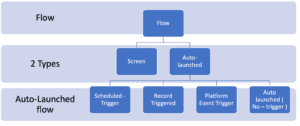In our previous blog post we had discussed about Introduction to Salesforce Flows.In these blog post we discuss about Types of Flows in Salesforce
Contents
Types of Flows in Salesforce
Salesforce Flows
Salesforce Flows are automation tools that guide users through a series of steps to complete a task. These tasks can range from data entry and updates to more complex processes like approvals and notifications. The main purpose of flows is to streamline and automate workflows, making it easier for users to complete tasks efficiently.
Key Benefits
- Increased Efficiency: Automate repetitive tasks, freeing up time for more strategic work.
- Consistency: Ensure that processes are followed uniformly across the organization.
- Flexibility: Easily adapt to changing business requirements without extensive coding.
Types of Salesforce Flows

Screen Flows
Screen Flows are interactive flows that require user input. They present a series of screens to the user, guiding them through a process step-by-step.
Use Cases
- User onboarding processes
- Guided data entry
- Complex decision trees
Step-by-Step Example
Imagine you need to create a flow for onboarding new employees. The flow can collect information like personal details, assign tasks for IT setup, and notify the HR department.
Autolaunched Flows
Autolaunched Flows run automatically without user interaction. They are typically triggered by processes or actions within Salesforce.
Use Cases
- Automated data updates
- Record creation based on specific criteria
- Integration with external systems
Step-by-Step Example
Consider a scenario where you need to update contact records automatically when an account is updated. An autolaunched flow can handle this by updating all related contact records whenever an account’s information changes.
Schedule-Triggered Flows
Schedule-Triggered Flows run at specified times, making them ideal for time-based automation tasks.
Use Cases
- Regular data backups
- Scheduled reports
- Periodic updates to records
Step-by-Step Example
Suppose you need to generate and send weekly sales reports to your team. A schedule-triggered flow can be set to run every Monday morning, pulling the necessary data and emailing the report to the team.
Record-Triggered Flows
Record-Triggered Flows are initiated when a record is created or updated. They are highly versatile and can be used to automate responses to changes in data.
Use Cases
- Trigger notifications on record updates
- Automatically update related records
- Enforce business rules
Step-by-Step Example
For instance, when a new opportunity is created, a record-triggered flow can automatically assign it to a sales representative based on predefined criteria.
Choosing the Right Flow Type
Factors to Consider
- Interaction Requirement: Determine if the flow needs user input.
- Trigger Mechanism: Decide if the flow should be initiated by a schedule, record change, or other criteria.
- Complexity of Process: Assess the complexity of the task to determine the appropriate flow type.
Best Practices
- Start with a clear understanding of the process you want to automate.
- Use screen flows for user-guided processes and autolaunched or triggered flows for background tasks.
- Test thoroughly before deploying flows to production.
Common Use Cases for Salesforce Flows
Automation of Business Processes
Flows can automate a wide range of business processes, from simple tasks like updating records to more complex processes like approval workflows and order processing.
Data Management and Manipulation
Flows can help manage and manipulate data efficiently, ensuring data consistency and reducing the chances of errors.
Integration with Other Systems
Flows can integrate Salesforce with other systems, enabling seamless data exchange and process synchronization across platforms.
Advanced Flow Features
Flow Variables
Variables in flows are used to store and manage data throughout the flow, allowing for dynamic operations and decision-making.
Flow Loops
Loops enable repetitive actions within a flow, such as processing a list of records or performing a task multiple times.
Flow Actions
Actions in flows can include creating, updating, or deleting records, sending emails, and more, providing a wide range of functionalities to enhance business processes.
Flow Debugging and Testing
Debugging Techniques
- Use debug logs to trace flow execution and identify issues.
- Test flows in a sandbox environment before deploying to production.
Testing Best Practices
- Create test scenarios that cover all possible paths and conditions.
- Involve end-users in testing to ensure the flow meets their needs.
Security and Permissions for Flows
User Permissions
Ensure that users have the necessary permissions to execute flows and access the required data.
Flow Security Settings
Configure flow security settings to protect sensitive data and maintain compliance with organizational policies.
Tips for Optimizing Salesforce Flows
Performance Considerations
- Minimize the number of steps and decision points in a flow.
- Optimize data retrieval and processing to reduce execution time.
Maintenance Tips
- Regularly review and update flows to ensure they meet current business needs.
- Document flows thoroughly to aid in future troubleshooting and updates.
Real-World Examples
Success Stories
Organizations have successfully used Salesforce flows to automate complex processes, improve data accuracy, and enhance user experience, resulting in significant time and cost savings.
Case Studies
Case studies highlight how specific companies have implemented flows to address unique challenges, demonstrating the versatility and effectiveness of Salesforce flows.
Conclusion
Salesforce Flows offer a robust solution for automating and optimizing business processes. By understanding the different types of flows and their use cases, organizations can leverage these tools to enhance efficiency, consistency, and flexibility. As Salesforce continues to evolve, the future of flows promises even more powerful capabilities to meet the growing needs of businesses.
We want more about Types of Flows in Salesforce Click Here
FAQs
What are the different types of flows in Salesforce?
Salesforce offers four main types of flows: Screen Flows, Autolaunched Flows, Schedule-Triggered Flows, and Record-Triggered Flows.
How do you decide which type of flow to use?
Choose based on the requirement for user interaction, the trigger mechanism, and the complexity of the process you need to automate.
Can flows be scheduled in Salesforce?
Yes, Schedule-Triggered Flows can be set to run at specific times, making them ideal for time-based automation tasks.
How do you debug a Salesforce flow?
Use debug logs to trace execution, test flows in a sandbox environment, and create test scenarios to cover all possible paths and conditions.
What are some common use cases for Salesforce flows?
Common use cases include automating business processes, managing and manipulating data, and integrating Salesforce with other systems.
In our next blog post we will discuss about Types of Resources in Salesforce Flows

2 thoughts on “Types of Flows in Salesforce”